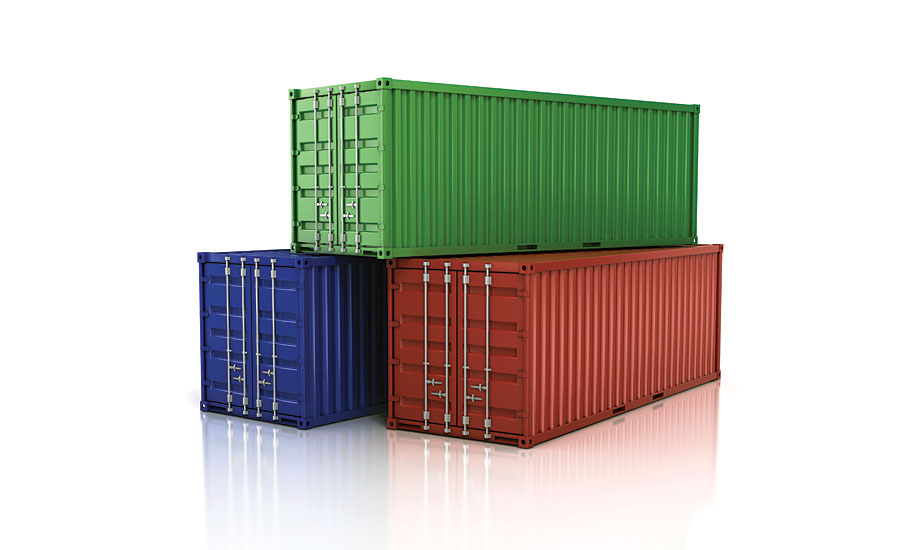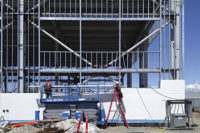Used shipping containers are cheap and abundant. At any given moment there are roughly 17 million of them in use worldwide. When they reach the end of their voyaging lives, sometimes after only a few uses, they end up in salvage yards or on Craigslist, waiting for someone to repurpose them. My local Craigslist currently has over 300 listings for shipping containers of various sizes ranging in price from about $3,000 to $9,000. The recent craze to repurpose shipping containers into habitable spaces has led to numerous backyard sheds, homes, offices, bars and restaurants. And very recently a new reason for repurposing these steel boxes has sprouted: agriculture.
The State of California produces the lion’s share of all produce consumed in the U.S.—99 percent of artichokes, 89 percent of cauliflower, 90 percent of leaf lettuce, 86 percent of lemons, 88 percent of strawberries, and the list goes on and on. Unless you live under a rock, you know that California is experiencing a severe decade-long-and-counting drought. What you may not know is that 77 percent of all the water used in California is devoted to agriculture. Continuing drought conditions are now taking their toll on California’s ability to produce America’s fruits and veggies.
Within the last couple of years or so, several entrepreneurial startups began converting used shipping containers into growing labs. I use the word labs because the conversion includes white interior finishes and the installation of high tech equipment including HVAC, lighting, and hydroponics—all carefully monitored and controlled with sophisticated computer software. These are not backyard greenhouses. Freight Farms, located in Boston, Mass., sells a fully-operational up-cycled container called the Leafy Green Machine for $76,000. One LGM can produce herbs, lettuces and Brassica (cabbage, kale, Brussels sprouts) at commercial-scale yields in any climate, in any season. One LGM can expect to produce over 500 heads of lettuce per week while using 80kWh of electricity a day. Total cost of operation is approximately $13,000-per-year which includes electricity, water, packaging and growing supplies.
Three years ago a retired Boston couple decided to give the whole thing a go and bought themselves a Leafy Green Machine from Freight Farms and named themselves Corner Stalk Farms. That single LGM has grown to five, which the owners have discovered is beyond their break-even point. The couple works full time and they sell everything they produce to local markets and restaurants.
Not Just Lettuce and Herbs
Crop Box, another company in the arena, was started by Williamson Greenhouses which revolutionized the tobacco industry 35 years ago with its greenhouse hydroponic tobacco production ideas. Crop Box will sell you a fully operational lettuce farm in a box like Freight Farms, but it will also sell you a box configured to grow food for livestock such as barley sprouts, alfalfa, and orchard grass. Crop Box is also busy working out the final details for a box that will be set up to grow strawberries.
Why Not Just Build a Greenhouse?
Greenhouses have been a year-round growing alternative to traditional agriculture for many years. They are efficient, they provide multiple crop cycles, have a high yield-per-acre, and use much less fertilizer than required for open field growing. Shipping container agriculture offers all of these advantages and then some.
According to Crop Box, growing cycles are greater (8-per-year for lettuce versus 6 for a greenhouse), enjoy year-round production (greenhouses are dependent on the sun and the weather) with guaranteed production and consistent yields, use significantly less water (90 percent less than traditional agriculture) and can be located very close to points-of-sale, nearly eliminating distribution costs and resources.
All of these advantages are huge, but the biggest advantage is scalability. Because shipping containers are meant to be packed into the smallest possible space, they are designed to be stackable. Crop Box allows stacking up to 5 containers high. This feature allows a farmer to start small and add (or remove) as demand fluctuates, with minimal disruption and space requirements.
How About Pot Boxes?
Crops in boxes is not a new concept to the cannabis farming community. Since the legalization of medical marijuana in the U.S., cannabis farmers have been perfecting the use of shipping containers to grow their crops. In the early 2000s, a company called PharmPods began developing turnkey pot growing freight boxes to the marijuana growing community.
It offers plug and play units at a starting cost of about $40,000. Unlike the units offered by food crop competitors, PharmPods units are uninsulated and meant to be installed in the dozens, stacked in a large, conditioned interior space (like a warehouse).
The recent interest and growth in food crop box production has not been lost on PharmPods, and the company is currently in the process of evaluating offering such a product as well. With PharmPods’ experience and expertise at large scalability of crops in boxes, it would be possible to have very large shipping container farms, with multiple crop varieties.




Report Abusive Comment